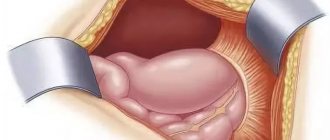The pancreas and hypertension are two interrelated ailments, the pathological manifestation of which is observed with the development of pancreatic disease of a parenchymal organ. Mostly elderly people are prone to the development of such changes in the cardiovascular system of organs during pancreatitis, in whom there is a sharp jump in blood pressure for a short period of time, after which it begins to rapidly decrease to a critical level. All this begins to occur against the background of the development of an inflammatory process in the pancreatic cavity, which activates the intoxication of all internal organs in the body and other pathogenic factors. In this review, we will look in more detail at whether pressure can increase during pancreatitis, what affects changes in blood pressure, how hypertension manifests itself, and how its indicators change in pancreatic disease, and also consider the main preventive measures aimed at preventing pathological changes in blood pressure.
Causes of development of pancreatic hypertension
A number of negative factors, the occurrence of which is caused by inflammation of the pancreas, can provoke changes in blood pressure.
Against the background of an acute attack (exacerbation of a chronic process), disruptions in the functioning of the gland occur: a decrease in the intensity of the produced substances required for adequate functioning of the body, premature activation of pancreatic enzymes before entering the lumen of the duodenum. They begin to work in the thickness of the organ, starting the process of autolysis (self-digestion) of the gland parenchyma with their own proteolytic enzymes. The result of such processing is the entry into the systemic bloodstream of toxic substances that contribute to poisoning of the body.
Reasons for the formation of pancreatic hypertension:
- development of intoxication syndrome - tissue breakdown products enter the systemic bloodstream:
- decreased activity of the digestive process, and the occurrence of rotting and fermentation;
- impaired absorption of various vitamins and microelements necessary to ensure the normal functioning of many systems;
- soft tissues become immune to the processes of diffusion of useful components, which negatively affects the functioning of organs;
- control of plasma glucose levels is impaired, which predisposes to the further development of diabetes mellitus.
Attention! All factors lead to a decrease in the activity of the immune response, which results in fluctuations in blood pressure. This is due to disruption of the autonomic nervous system (the tone of large arteries suffers).
Pressure with pancreatitis
What causes pancreatitis?
According to medical opinion, there is a fairly close relationship between parenchymal organ disease (pancreatitis) and blood pressure. Pancreatitis occurs as a result of a violation of the outflow of enzymes produced by the gland. Excessive accumulation inside the pancreas leads to self-digestion of the tissue structures of the gland by enzymes, stagnation of bile, and poor digestion of food in the intestines. Blood pressure changes sharply during the exacerbation phase of pancreatitis, sometimes even hypertensive attacks are recorded in the initial stages of development of the pathology. A similar clinical picture is often observed in older people who have problems with the heart and blood vessels.
Blood pressure may also drop sharply as a result of blood loss due to internal bleeding, which is typical in the acute stage of pancreatitis when iron tissue is damaged.
During an attack of pancreatitis in many patients, an increase in blood pressure is often accompanied by shortness of breath and tachycardia. Blue dots appear around the navel and on the lower back, and greenish spots appear in the perineal area. Such spots indicate that blood has penetrated the skin and urgent medical intervention is required.
How does pancreatitis affect arterial health?
In the acute phase of pancreatitis (especially with sharp progression), a person’s blood pressure undergoes significant changes. To avoid the development of serious complications, consultation with a specialist is required, even with minor manifestations of the disease.
Arterial blood pressure indicators
In the acute stage and during exacerbation
An attack of the disease is dangerous due to its lightning-fast development, during which autonomic regulation, the functioning of the gastrointestinal tract and the condition of the vascular wall suffer.
Acute pain leads to the development of a state of shock in the patient. Very often, it is pain shock that causes death. If such a risk is high, the patient can only be saved when timely intervention by doctors occurs. In this case, the leading symptom of a state of shock is the occurrence of surges in blood pressure. The reason for this is considered to be hemodynamic processes, which are provoked by the presence of inflammatory changes in the parenchyma of the gland.
It is important to know! As a response to a painful attack, there is a sharp jump in blood pressure, which is observed for a short period of time. Then the indicators decrease to very low numbers. This phase is called the torpid stage of shock.
The fall in blood pressure is affected by: the occurrence of internal bleeding (against the background of existing pancreatic necrosis). In this case, the pressure numbers will directly depend on the intensity of blood loss.
Severity of torpid phase:
- systolic pressure remains at 100 mm Hg. Art., which is accompanied by severe tachycardia, lethargy and decreased severity of reflexes;
- systolic pressure drops to 80 mm Hg. Art., the severity of tachycardia and lethargy increases, shallow breathing occurs;
- upper pressure decreases to 60 mm Hg. Art., the skin becomes pale and cyanotic, acute urinary retention occurs due to the cessation of the kidney system.
The third phase of shock requires hospitalization of the patient in the intensive care unit and resuscitation measures.
For chronic course and remission
During a period of stable remission or when the process is chronic, doctors more often diagnose such patients as having a tendency to hypotension.
Causes:
- development of vegetative-vascular dystonia;
- addition of heart and vascular diseases;
- various hypo- and vitamin deficiencies;
- depletion of body resources;
- development of iron deficiency and B12 deficiency anemia;
- the addition of diabetes mellitus and its complicated course;
- gastrointestinal pathologies.
Pancreas and blood pressure: relationship
Acute and chronic forms of pancreatitis affect blood pressure differently. In the first phase of the acute inflammatory process, blood pressure tends to increase due to hemodynamic changes in blood flow, also due to painful shock and rapidly progressing intoxication.
As the torpid stage of the disease develops, blood pressure indicators tend to decline, reaching a critical level. This provokes breathing problems, dysfunction of the heart and urinary system. With pancreatitis, the pressure begins to jump - a sharp rise is replaced by a sharp decrease.
A dangerous situation is when a decrease in indicators causes internal bleeding, which occurs with extensive death of pancreatic tissue. Chronic pancreatitis is accompanied by a long-term disruption of the normal functioning of the pancreas, so patients almost always exhibit hypotension.
The difficulty of diagnosing the disease is due to the fact that a huge number of pathological factors can provoke an increase in blood pressure, for example, concomitant pathologies, age.
Symptoms of a jump in blood counts against the background of pancreatic pathology
Features of clinical manifestations:
- attacks of dizziness begin to occur;
- headache appears;
- visual acuity decreases;
- a feeling of numbness and paresthesia in the area of the hands;
- sleep disturbance;
- psycho-emotional lability;
- the occurrence of nosebleeds;
- sensation of tinnitus;
- the formation of edema in the area of the upper and lower extremities;
- increased sweating;
- the occurrence of chest pain.
Inflammation of the pancreas and headaches: is there a connection?
What affects blood pressure
With inflammation of a parenchymal organ, blood pressure changes under the influence of:
- Intoxication resulting from inadequate digestion and developing fermentation. As a result, rotting of the food taken occurs, which leads to the proliferation of microbes, the waste products of which cause poisoning of the entire body;
- Nutrient deficiency resulting from insufficient functioning of the pancreas;
- Serious disorders of the pancreas, when the enzymatic elements necessary to maintain sugar levels and normalize the process of penetration of necessary substances into tissue structures are not produced.
Features of therapeutic therapy for a combination of various conditions
Therapy must be comprehensive. Its direction will depend on the existing blood pressure numbers: low or high, as well as on the patient’s condition. His age and the presence of concomitant somatic pathology.
Treatment involves prescribing medications that are aimed at relieving pain, relieving vascular spasm, or vice versa, increasing the tone of the vascular wall.
Attention! Do not forget about the treatment of pancreatitis itself. For this purpose, additionally antacids and enzyme agents are used, drugs that will activate intestinal motility, which will turn on the reparative mechanisms of the human body.
Surgeon intervention may be necessary if tissue abscess occurs or parenchymal necrosis develops. In these situations, partial resection of the gland will be required. With an advanced purulent process, when the abscess ruptures, diffuse peritonitis may develop. In this case, the surgeon will rinse and cleanse the abdominal organs of purulent masses and fibrin plaque, antibiotic solutions will be administered and drains will be installed to ensure complete outflow of pathological fluid.
Additionally, you can resort to the advice of traditional medicine. The main task of the patient is not to use herbs only as the only remedy, excluding what official medicine offers.
Herbs can be used only when the acute phase of the disease has passed. These include:
- a mixture of celandine, dandelion root, anise and corn silk;
- a decoction prepared from rose hips;
- freshly squeezed potato or beet juice;
- oat milk.
Pancreatitis: treatment
Treatment of acute pancreatitis with problematic blood pressure
At the moment of development of painful shock, a person needs to ensure complete emotional and physical peace. The room where the patient is located must be well ventilated to provide access to fresh air. In order not to interfere with the normal flow of blood and the body’s respiratory function, it is necessary to remove all tight clothing and shoes (if this is not possible, at least unfasten them as much as possible).
Doctors prescribe the following groups of pharmacological agents:
- antispasmodics
- no-shpa;
- drotaverine;
- platiphylline;
- papaverine;
- non-narcotic analgesics
- analgin;
- baralgin;
- spasmalgon;
- opioid analgesics
- morphine hydrochloride;
- omnopon;
- promedol;
- isotonic solutions;
- agents that improve systemic blood flow.
Interesting fact! In the case of the development of the third phase of the disease, when blood pressure levels drop below 60, resuscitation measures are indicated. They consist of additional oxygen delivery and intensive perfusion with appropriate medications.
Features of treatment of chronic pancreatitis with impaired blood pressure
In this situation, all therapeutic assistance should be aimed at treating the underlying disease and eliminating the causes that caused it.
The following medications may be recommended:
- nitroglycerin;
- baralgina;
- spasmalgona;
- caffeine;
- norepinephrine;
- bellaspon;
- hawthorn;
- Eleutherococcus;
- ginseng;
- immortelle.
Preventive measures
To prevent the development of the disease, simple rules must be followed:
- adherence to the basics of proper nutrition, where spicy, fatty and fried foods, canned food, salt will be excluded, and it should consist of products that will provide the body with the proper level of protein and potassium. Magnesium and calcium;
- do not forget about moderate physical activity, this can be not only classes in the gym, but also regular morning exercises, which is best combined with a set of breathing exercises;
- effectively supplement your day with cardio exercises, which include running, swimming in the pool, cycling, brisk walking;
- give up bad habits (alcohol, tobacco);
- Do not abuse strong tea and coffee.
Control your blood pressure
Pressure in chronic pancreatitis
Blood pressure indicators in chronic pancreatitis may change due to changes in the course of the pathology. With exacerbation, pressure drops are more pronounced.
In chronic pancreatitis, the patient is in a hypotonic state, that is, the pressure is constantly reduced due to impaired functions of the pancreas and the entire body.
Hypotension is detected by the following symptoms:
- The occurrence of problems with the cardiovascular system;
- The appearance of vitamin deficiency due to impaired absorption of nutrients;
- Weakness and exhaustion of the body as a result of vitamin deficiency;
- Anemia;
- Impaired sugar levels leading to diabetes;
- Diseases of the gastrointestinal tract.
If the patient has hypotension, the doctor begins the examination by checking the condition of the pancreas. Treatment begins with eliminating the root cause, not the symptoms. Physical exercise and adherence to the regimen are recommended.
Estimated forecast
For patients with pancreatitis, both low and high blood pressure are equally dangerous. But the worst thing is that the consequences of a sharp jump in blood pressure during an attack of the underlying disease cannot be predicted.
At this moment, the system provokes the launch of processes that are aimed at cleansing the body of toxic components. To achieve this, there is an increase in heart rate and acceleration of blood flow through the vessels. In individuals diagnosed with hypertension, the occurrence of an attack leads to an aggravation of the severity of hypertension.
Attention! The development of painful shock or the addition of uncontrollable vomiting is often the trigger that leads to cardiac arrest or the formation of hemorrhage in the brain tissue (the so-called hemorrhagic stroke).
If in this situation the patient is not provided with adequate medical care in the appropriate hospital department, then the likelihood that a stroke or extensive myocardial infarction will develop increases many times over.
The relationship between pancreatitis and the patient’s quality of life
Pressure surges due to pancreas pathology can cause significant harm to a person’s health and worsen their quality of life. To prevent such a situation, you must always seek medical help on time and monitor your lifestyle. Do not neglect the advice of doctors and strictly follow the recommendations received. Traditional medicine is great, but it cannot always replace the achievements of modern medicine.
Pathogenesis and blood pressure
After the onset of the disease, due to deviations in the bile ducts, gastric juice flows into the passages where enzymes mature. In such a situation, pressure increases and concomitant pathology of the sphincter of Oddi occurs. High blood pressure leads to a malfunction of the gland cells, after which they begin to self-digest. It can increase with a lack of secretin and this will provoke a disturbance in the outflow of pancreatic juice.
In this state, the amount of proteins increases, as a result of which similar plugs are formed. If the blood supply to the pancreatic tissues is disrupted, atrophy develops and tissue replacement occurs.
Migraine with pancreatitis occurs due to changes in blood pressure. As a rule, this is affected by intoxication of the body. It may occur during an exacerbation period. Its occurrence is provoked by poor digestibility of foods.
The pancreas controls the production of enzymatic elements (glucagon, insulin, somatostatin, polypeptide, ghrelin). If its operation is disrupted, a similar condition is observed in the process of producing the listed substances. With such a course, their enzymes can poison their own body.










